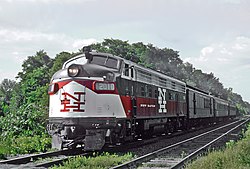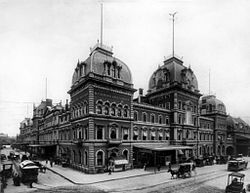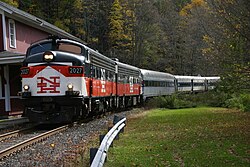Electric traction for railway trains; a book for students, electrical and mechanical engineers, superintendents of motive power and others (1911) (14778718213)
Identifier: electrictraction00burc (find matches)
Title: Electric traction for railway trains; a book for students, electrical and mechanical engineers, superintendents of motive power and others ..
Year: 1911 (1910s)
Authors: Burch, Edward P. (Edward Parris), 1870-1945
Subjects: Railroads
Publisher: New York (etc.) McGraw-Hill Book Company
Contributing Library: The Library of Congress
Digitizing Sponsor: The Library of Congress
View Book Page: Book Viewer
About This Book: Catalog Entry
View All Images: All Images From Book
Click here to view book online to see this illustration in context in a browseable online version of this book.
Text Appearing Before Image:
e miles per month per locomotive owned exceeds 4000. See page 280. The commutators, while black, are in a very good condition. Brushes makefrom 22,000 miles on an average, and 34,000 miles as a maximum. Commutatorsaverage about 95,000 locomotive miles between turnings. Tire wear is the principal reason for taking locomotives out of service. Curveson the New York division are many and severe. Water on the track, from high winds and tides, has at times damaged the wiring.One-fifth of the locomotives, on several occasions during 1908 and 1909, were com- 368 ELECTRIC TRACTION FOR RAILWAY TRAINS pelled to run thru water 20 inches deep, for long distances at full speed. The saltwater in the motor casings and ducts could have been dried out by the applicationof the lowest alternating current voltages if the alternating current had been avail-able; but the trouble occurred on the 660-volt, direct-current, third-rail section, andthe wiring of first motor of the four in the series would ground.
Text Appearing After Image:
Fig. 138.—Two New York, New Haven and Hartford Passenger Locomotives and 15-car Train. Inspection of electric locomotives are made every 12 days, or every1600 locomotive miles. Steam locomotives require inspection every100 miles, and must be sent to the back shop for overhaul every 2months, or about every 40,000 to 60,000 miles, depending upon the serviceand the water used. Electric locomotives seldom require a generaloverhaul. The time required for inspection is 4 to 12 hours. Of the 41passenger locomotives, 3 are in for inspection each day, in summer. Maintenance expense, which includes all repairs, was at first 7 centsper locomotive mile, but this has now been reduced to 5 cents, of which3.5 cents are for labor and 1.5 cents for material. Locomotive troubles have been detailed and explained by Mr. Murray,Electrical Engineer for the road, to the A. I. E. E., Dec, 1908; Apr., 1911.The new designs had many minor troubles, as was expected, but theydisappeared in time. The most wonder
Note About Images
Relevante Bilder
Relevante Artikel
New York, New Haven and Hartford RailroadDie New York, New Haven and Hartford Railroad, abgekürzt NH oder NYNH&HR, oft nur New Haven genannt, war eine Eisenbahngesellschaft, die ihr Streckennetz in den südlichen Neu-England-Staaten der USA betrieben hatte. .. weiterlesen
EMD FL9Die FL9 ist eine Baureihe dieselelektrischer Lokomotiven der General Motors Electro-Motive Division (EMD), die als Zweikraftlokomotiven zugleich rein elektrisch betrieben werden können. .. weiterlesen
New Haven LineDie New Haven Line ist eine Eisenbahnstrecke im Norden von New York City, die von New Haven, Connecticut nach Mount Vernon, New York verläuft. Die Strecke gehörte der ehemaligen New Haven Railroad (NH) und wird heute von der Metro-North Railroad betrieben. Sie ist viergleisig ausgebaut und Teil der Fernverkehrsverbindung Boston–Washington, D.C., die als Northeast Corridor (NEC) bezeichnet wird. Mit täglich 125.000 beförderten Passagieren ist die New Haven Line die meistbefahrene Eisenbahnstrecke der USA. .. weiterlesen



























